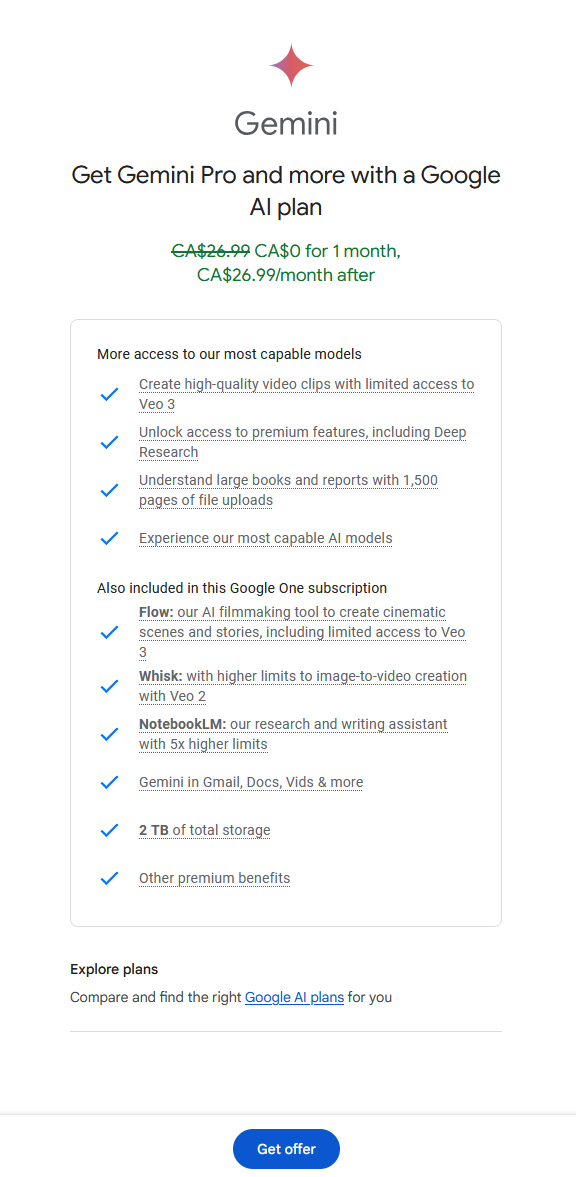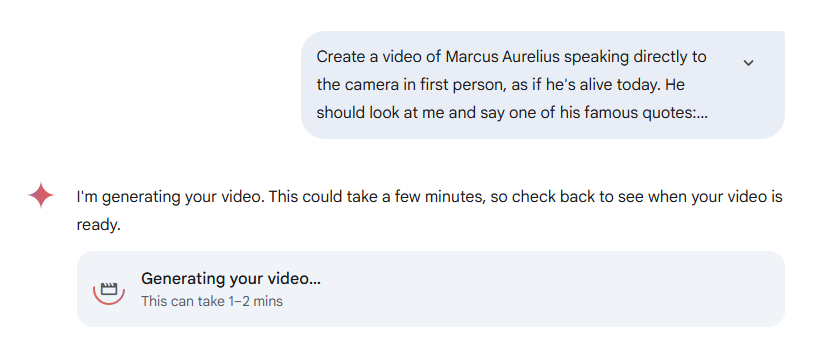Veo 3: The Best and Worst of the New Era of Video Generation
When Veo 3 was released in May 2025, many videos were uploaded to YouTube and shared across every social platform, taking the world by surprise. The quality, the realism, the accuracy—everything looked so real that, for many videos, it was impossible to tell whether they were real or not.
For example, a car show that didn’t even happen:
Amazing? It was 100% generated by AI. But wait, there are way more videos to see:
These videos look insanely real—and in this article, we’ll discover how easy it is to create your own realistic video.
Getting Started
The first thing you need to do is create an account on Google Gemini: 👉 https://gemini.google.com/app
To generate videos, you'll need a Gemini Pro account, which costs around $20 USD per month (price may vary depending on your country and currency).


Once that’s done, simply click on "Video", describe what you want to generate, and press Enter—voilà! 🎬

It usually takes between 1–2 minutes to generate a video around 8 seconds long.

Real Example
For all the prompts I used, I first wrote a basic version, then asked the AI to improve it to make sure the final video would look better.
The Past Comes Alive
One of the most exciting things about this new technology is how we’ll be able to learn history, science, geography, philosophy, and more in a completely new way. We'll be able to learn directly from the people who shaped history—or at least a realistic representation of them.
For example, here’s the prompt and the video I used to make Marcus Aurelius speak to us and share one of his most famous quotes:
Create a video of Marcus Aurelius speaking directly to the camera in first person, as if he's alive today. He should look at me and say one of his famous quotes: 'The happiness of your life depends upon the quality of your thoughts.' Make it feel personal and reflective, as if he's offering timeless wisdom directly to me.
Easy Self-Advertising
For small companies, it’s now easier than ever to create short and engaging ads. Earlier in this article, we saw a video of a car show that never even happened—and it looked real.
My own paid product, Entity Framework Extensions, is known for saving data very fast.
So here's the prompt and video I used to simulate a real review from someone at a tech conference:
Create a video scene at a buzzing tech conference. The crowd is excited and visibly impressed by the performance of the library Entity Framework Extensions. Capture the energy and reactions of the attendees. A developer is being interviewed on camera, laughing and saying: 'Man, this is crazy — even Usain Bolt isn’t as fast as Entity Framework Extensions!
Video Cinematics
My guess is that in a few years, many video games will use AI to create stunning cinematics—and even students might use it in their PowerPoint presentations. In both cases, they often don’t have a big budget, and with AI, they won’t need one anymore.
Here’s some “proof” that aliens and dinosaurs built the pyramids…
Create a cinematic video showing aliens in ancient Egypt using dinosaurs to build the pyramids. The scene should include futuristic alien technology mixed with primitive tools, as massive dinosaurs carry huge stones while aliens direct them. The setting is the Egyptian desert with partially constructed pyramids in the background, and the mood should feel epic and mysterious.
Limitations
By now, you’ve probably realized that creating videos with Veo 3 is very easy—and that’s one of its biggest strengths.
However, there are still many limitations:
- Maximum 3 videos per day – This makes it hard to fully explore or experiment with Veo 3.
- Maximum 8 seconds per video – Often too short to clearly express your ideas.
- No support for pictures or popular people – This limits creativity in certain use cases.
And there are several more limitations. But keep in mind: Veo 3 is still new. In a year, I have no doubt we’ll be able to generate 30–60 second videos, and the daily limit will likely increase.
Some limitations may eventually be lifted—like being able to upload a photo of yourself and bring it to life, just like with tools such as Vidfly. Using their free plan, I was able to generate a short 5-second video where I come to life:
While I expect Veo 3 to evolve quickly, I also believe the real game-changer might come from its competitors, especially those fully focused on video generation.
Future Concern
AI becomes more realistic every day. In the early days, it was easy to tell if an image was AI-generated—people had 7 fingers, 3 arms, and other obvious flaws. But now, even videos look completely real.
From my perspective, we’ve lived—and will live—through distinct digital eras:
- 2000s – The era of information: Knowledge became accessible to everyone.
- 2010s – The era of disinformation: The internet became flooded with fake news, and some people enjoyed spreading it.
- 2020s – The era of propaganda: If you didn’t think like the majority, you were silenced or excluded.
- 2030s – The era of fake: Fake politicians talking, fake videos of your children, fake everything. It will become nearly impossible to trust what you read or see.
Just imagine what kind of videos will be possible by 2030. Many people will use this technology for good: making movies, educational courses, and creative entertainment.
But others will use it for harm.
We already can’t fully trust voices—AI tools like ElevenLabs can clone someone’s voice with shocking accuracy. And soon, we won’t be able to trust what we see either.
Here’s what might happen:
- Some couples will break up over situations that never happened.
- Some artists will lose everything over fake videos they were never in.
- Some grandparents will be manipulated after seeing a fake video of their grandchild being harmed and asking for money.
- Some victims will suffer from deepfake revenge porn.
Back in 2020, we talked a lot about the metaverse, which never really took off. But in 2030, we may be living in the fakerverse—a world where everything could be fake, and many people will exploit it.
It won’t matter whether a video is true or not. Just the accusation can destroy someone’s life. People tend to judge before verifying, and by then, the damage is already done.
To create a fake video, someone only needs a photo of you and a 4-second voice clip—which can easily be found on Facebook, Instagram, TikTok, and other platforms. From there, they can make you say or do anything.
Imagine this: You have a family. One day, you receive an email with a video of yourself. They demand $5,000, or they’ll release it everywhere. The video never actually happened—but for most people who see it, it’s all the proof they need.
More than ever, trust will become everything. You’ll need to trust your partner, your friends, and your instincts—because the reverse will also happen. Something real will happen, and someone will say, “Don’t worry, it was just AI.”
Conclusion
I had a lot of fun generating these videos and writing this article. However, the 3 videos per day limit was clearly a big restriction. I felt like I couldn’t fully explore or take advantage of this new feature. It’s frustrating to have multiple ideas and only be able to generate 3 videos—when I really wanted to make 10–20 videos in a single session.
As you’ve seen, I have no doubt that video generation will bring tons of benefits. But it will also come with a heavy cost: we won’t be able to trust videos anymore.
Today, it's already hard to trust the news—we constantly have to fact-check everything. But at least, we used to say: "Seeing is believing."
Well... not anymore.